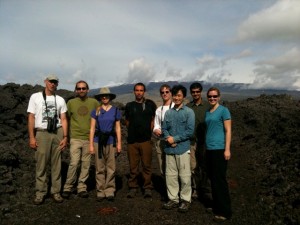| by Marcia Goodrich, Michigan Tech magazine editor
Pressure-treated wood is great stuff, but the chemicals used to preserve it from decay can leach out, where they can be toxic to bugs, fungi and other hapless creatures that have the bad luck to be in the neighborhood. Now, a team of scientists has used nanotechnology to keep the chemicals inside the wood where they belong. “It’s a new method that uses nanoparticles to deliver preservatives into the lumber,” said chemistry professor Patricia Heiden. “In our experiments, it reduced the leaching of biocides by 90 percent.” The nanoparticles are tiny spheres of gelatin or chitosan (a material found in the shells of shrimp and other shellfish) chemically modified to surround the fungicide tebuconazole. The little spheres require no special handling. “You just pressure-treat the wood in the usual way,” Heiden said. The initial tests show that the nanoparticle-treated wood is just as resistant to rot and insects as conventionally treated lumber. The researchers are now testing the wood in the warm, wet weather of Hawaii. The research is funded by the US Environmental Protection Agency. Also contributing to the project are chemistry PhD student Xiaochu Ding and, from the School of Forest Research and Environmental Science, Research Engineer/Scientist II Dana Richter, Senior Research Engineer/Scientist Glenn Larkin, Assistant Research Scientist Erik Keranen and Professor Peter Laks. |

Professor David Flaspohler is participating in a 5-year NSF-funded research project to better understand how birds interact with naturally fragmented forests created by lava flows. He and his team are finding and monitoring nests and color banding individual birds in 34 forest fragments that vary in size from 0.2 ha to 30 ha in mid-elevation native Hawaiian forests. In half of these fragments, we will remove the introduced non-native black rat, and in the other half we will not. Rats are known nest predators that also compete with birds for insect food so their influence on the food web and on the reproductive success of the birds may be strong. The work is being conducted by Dr. Flaspholer, Dr. Jessie Knowlton (Michigan Tech post-doctoral associate), and 4 bird interns. Other collaborators are from Stanford University, the University of Maryland, and the USFS, Institute of Pacific Island Forestry.
See more pictures at: Flaspohler Hawaiian Sabbatical
 Professor David Flaspohler has received $72,512 from the National Science Foundation for the first year of a potential five-year, $349,488-project, “Interactive effects of predation and ecosystem size on arthropod food webs in Hawaiian forests fragmented by lava flows.”
Professor David Flaspohler has received $72,512 from the National Science Foundation for the first year of a potential five-year, $349,488-project, “Interactive effects of predation and ecosystem size on arthropod food webs in Hawaiian forests fragmented by lava flows.”